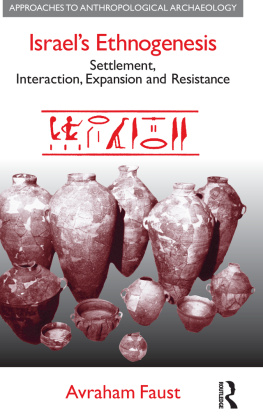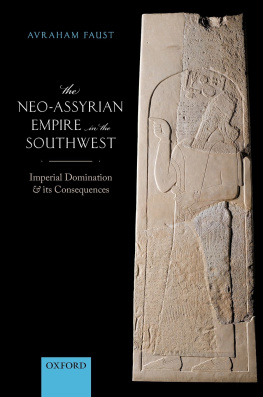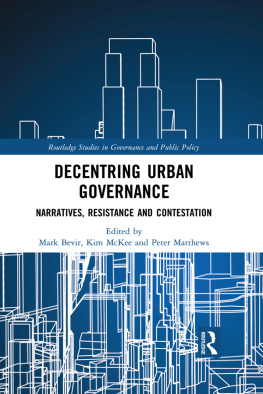ISRAEL'S ETHNOGENESIS
Avraham Faust
Israels Ethnogenesis:
Settlement, Interaction, Expansion and Resistance
Avraham Faust
First published 2006 by Equinox, an imprint of Acumen
Published 2014 by Routledge
2 Park Square, Milton Park, Abingdon, Oxon, OX14 4RN
711 Third Avenue, New York, NY 10017, USA
Routledge is an imprint of the Taylor & Francis Group, an informa business
Avraham Faust 2006
All rights reserved. No part of this book may be reprinted or reproduced or utilised in any form or by any electronic, mechanical, or other means, now known or hereafter invented, including photocopying and recording or in any information storage or retrieval system, without permission in writing from the publishers.
Notices
Practitioners and researchers must always rely on their own experience and knowledge in evaluating and using any information, methods, compounds, or experiments described herein. In using such information or methods they should be mindful of their own safety and the safety of others, including parties for whom they have a professional responsibility.
To the fullest extent of the law, neither the Publisher nor the authors, contributors, or editors, assume any liability for any injury and/or damage to persons or property as a matter of products liability, negligence or otherwise, or from any use or operation of any methods, products, instructions, or ideas contained in the material herein.
Library of Congress Cataloguing-in-Publication Data
A catalogue record for this book is available from the Library of Congress
ISBN 978-1-904768-98-2 (hbk)
ISBN 978-1-84553-456-1 (pbk)
Typeset by Forthcoming Publications Ltd.
To my parents
Yosef (Yosh) and Ya'el Faust
Contents
Part I
INTRODUCTION |
Chapter 1
INTRODUCTION |
Chapter 2
ARCHAEOLOGY AND ETHNICITY |
Chapter 3
ISRAELITE ETHNICITY: STATE OF RESEARCH |
Part II
AN ARCHAEOLOGICAL EXAMINATION
OF ISRAELITE ETHNICITY |
Chapter 4
ISRAELITE MARKERS AND BEHAVIOR |
Chapter 5
MEAT CONSUMPTION |
Chapter 6
DECORATED POTTERY |
Chapter 7
IMPORTED POTTERY |
Chapter 8
POTTERY FORMS AND REPERTOIRE |
Chapter 9
THE FOUR-ROOM HOUSE |
Chapter 10
CIRCUMCISION AND ETHNICITY |
Chapter 11
HIERARCHY AND EQUALITY:
THE ROOTS OF THE ISRAELITE EGALITARIAN ETHOS |
Part III
ISRAEL'S IDENTITY AND THE PHILISTINES |
Chapter 12
SETTLEMENT PATTERNS
IN THE IRON AGE I-IRON AGE II TRANSITION |
Chapter 13
ETHNICITY AND STATEHOOD IN ANCIENT ISRAEL |
Chapter 14
THE PHILISTINES IN THE IRON AGE I |
Chapter 15
TOTEMISM TO ETHNICITY:
THE PHILISTINES AND ISRAEL'S SELF-IDENTIFICATION |
Part IV
MERENPTAH'S ISRAEL: THE BEGINNINGS |
Chapter 16
MERENPTAH'S ISRAEL:
ISRAEL IN THE LATE THIRTEENTH CENTURY BCE |
Chapter 17
ISRAEL'S EMERGENCE: THE BEGINNINGS |
Chapter 18
ORIGINS RECONSIDERED |
Part V
ASPECTS OF DISTRIBUTION |
Chapter 19
POTS AND PEOPLES REVISITED:
ISRAELITES, PHILISTINES AND CANAANITES |
Chapter 20
TRANSJORDAN REVISITED |
Chapter 21
SUMMARY AND CONCLUSIONS |
Chapter 22
POSTSCRIPT |
Distribution Map of Imported Pottery in the Land of Israel
in the Iron Age II |
Access Analysis of a Typical Four-Room House,
as Compared to a Typical CanaanitePhoenician House |
A Table of Iron I Villages Destroyed or Abandoned
before the Iron II |
Schematic Map Showing the Two Phases
of Iron I Sites' Abandonment |
Many articles and books have been devoted to Israel's emergence in Canaan, and have attempted to identify the earliest Israel in the archaeological record. While the equation of the settlers in the Iron Age I highland villages with the Israelites seems to have been quite straightforward in the past, this identification has become one of the hottest debates in the archaeology of ancient Israel and even in biblical studies; views regarding the timing of Israel's emergence as an ethnic group and the processes which led to it and accompanied it vary greatly. The present book attempts to trace Israelite ethnic markers and ethnically specific behaviors, and to identify the historical contexts in which they became such; it concludes that Israel's emergence was a long and complex process, which covers the entire Iron Age I (with ethnic negotiations continuing even later).
While many advances were made in recent years, the present monograph differs from most previous works by a combination of several factors: Its scope, it's focus on the archaeological record, its position as part of a wider study of Iron Age society, and, consequently, its research questions.
Most recent treatments of ancient Israel have been carried out in articles. Yet ethnicity is one of the most problematic topics in archaeology in general, while the question of ethnogenesis is even more obscure. Articles, therefore, cannot adequately deal with such a complex issue, and will always leave much unanswered, particularly when dealing with such a difficult case-study. Furthermore, even the majority of the books published recently on the topic differ greatly from the present worknot only are many textually oriented, but almost all of them deal with Israelite ethnicity as part of an interest in Israel's 'political history'. They focus on ethnicity mainly because it became a major issue in determining questions such as the historicity of the Bible, or of various narratives within it. I believe ethnicity cannot be studied in isolation from other aspects of society, and that such an 'isolationist' approach is part of the reason for the dead-end we have presently reached in this area of study.
This book is part of large-scale examination of Iron Age society of ancient Israel, and ethnicity is therefore analyzed within what I believe is a more appropriate framework. Moreover, the scope of the book and the discussion of various elements enables us to examine each of the interpretations suggested to the observed patterns within the period's context (cf. Hodder's contextual archaeology), thus strengthening its probability. While the written sources serve mainly as a second fiddle, usually only at the second stage of the analysis, they also provide a context against which to examine the likelihood of the proposed explanations.
The written sources, and especially the Bible, are indeed invaluable sources that can give us insights into the society that produced them. The mere existence of these texts gives the study of Israelite ethnicity an advantage over the study of other ethnic groups in antiquity. However, due to the fragmentary nature of the texts and their debated historicity, they typically were used here as a secondary source only, although in a few chapters they merited a central role. In most cases, the discussion is decisively archaeological in orientation. That is, Iron Age archaeological data was thoroughly examined, and its social significance was studied. While only aspects seemingly relevant for the study of ethnicity were discussed in this book, this procedure ensured that the research agenda was for the most part dictated by the archaeological evidence; the texts were incorporated only within an archaeologically established research framework. And this holds true for even the more 'biblical' chapters, such as the one on circumcisionthe biblical data was incorporated within a larger framework based on the archaeological data. With this, I have reversed the traditional relationship between the two sources of information in most biblical archaeological studies.







